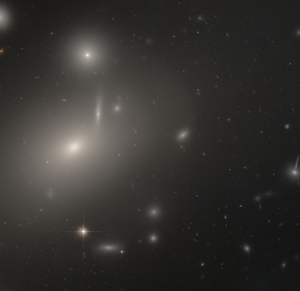NGC 4889
| Galaxy NGC 4889 / NGC 4884 |
|
|---|---|

|
|
| The elliptical galaxy NGC 4889 (left) captured by the Hubble Space Telescope | |
| AladinLite | |
| Constellation | Berenike's hair |
|
Position equinox : J2000.0 , epoch : J2000.0 |
|
| Right ascension | 13 h 00 m 08.1 s |
| declination | + 27 ° 58 ′ 37 ″ |
| Appearance | |
| Morphological type | cD; E4; Dd / PAS |
| Brightness (visual) | 11.5 likes |
| Brightness (B-band) | 12.5 mag |
| Angular expansion | 2.8 ′ × 2 ′ |
| Position angle | 80 ° |
| Surface brightness | 13.4 mag / arcmin² |
| Physical data | |
| Affiliation |
Coma Pile Abell 1656 |
| Redshift | 0.021665 ± 0.000043 |
| Radial velocity | (6495 ± 13) km / s |
|
Stroke distance v rad / H 0 |
(291 ± 20) x 10 6 ly (89.2 ± 6.2) Mpc |
| history | |
| discovery | Wilhelm Herschel |
| Discovery date | April 11, 1785 |
| Catalog names | |
| NGC 4889/4884 • UGC 8110 • PGC 44715 • CGCG 160-241 • MCG + 05-31-077 • 2MASX J13000809 + 2758372 • GC 3351 • H II 391 • h 1507 • LDCE 0926 NED051 | |
NGC 4889 is a very large elliptical galaxy in the constellation Haar der Berenike , located almost in the center of the Coma Cluster and about 291 million light years from the Milky Way.
It is of the cD galaxy type and dominates - together with a second, somewhat weaker giant galaxy called NGC 4874 - the gravity field of the galaxy cluster . The two star systems are very old and probably formed from the merging of several small spiral galaxies .
NGC 4889 was discovered on April 11, 1785 by the German-British astronomer Wilhelm Herschel . In 1973, Jack Sulentic and William Tifft declared the galaxy NGC 4884, described by Heinrich Ludwig d'Arrest on April 6, 1864, to be identical to NGC 4889 in the RNGC .
In the center of NGC 4889 is the largest black hole that has been directly measured to date (as of December 2019) , with a mass of an estimated 21 billion solar masses ('best fit' from the range 6 to 37 billion solar masses).
Web links
Individual evidence
- ↑ a b c d e NASA / IPAC EXTRAGALACTIC DATABASE
- ↑ a b c d e SEDS : NGC 4889
- ↑ Seligman
- ^ Nicholas J. McConnell: Two ten-billion-solar-mass black holes at the centers of giant elliptical galaxies . Nature. December 8, 2011. Archived from the original on December 6, 2011. Retrieved on December 6, 2011.

